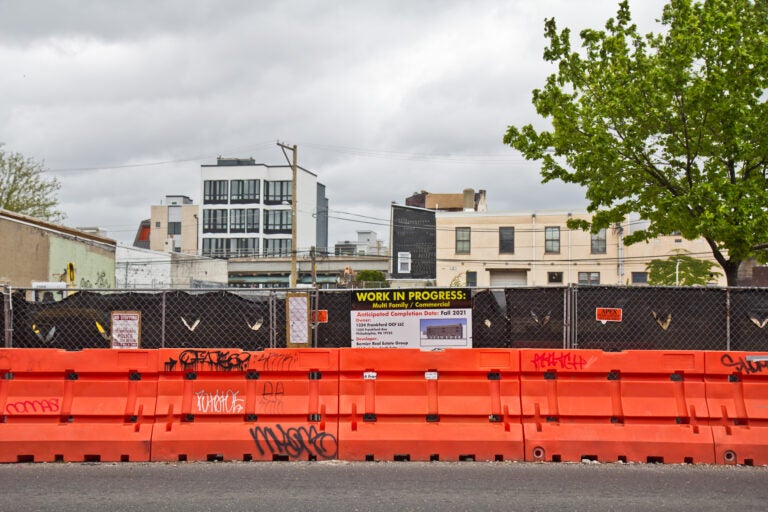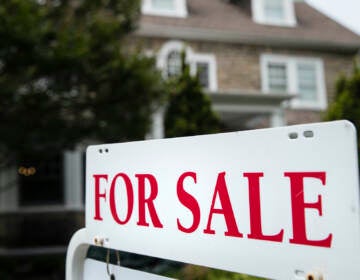Is urbanism a fantasy of racialized capitalism?
Why is a movement dedicated to the vitality of cities so focused on commercial real estate?

Construction at 1324 Frankford Avenue in Fishtown. (Kimberly Paynter/WHYY)
I’ve always had a fraught relationship with urbanism.
The first time I heard the term was 5 years ago, when I first became president of my neighborhood association and a commenter on an online group touted my election as one of a few “new, young urbanists taking over neighborhood associations.” I had never heard the term before and had no idea what he was talking about.
What profile did I fit that someone would assume I’m an urbanist?
The Oxford Dictionary defines urbanist as “an advocate of or expert in city planning.” This definition makes a false equivalency between advocate and expert. But what it more deeply implies is that by identifying as an urbanist, you somehow know what’s good for other communities which you are not a part of. This is the exact mindset that drives white supremacy and has driven flawed city planning policy, such as urban renewal and broken windows policing.
Pretty quickly, my unease was compounded as I read the commentary in Philly’s urbanist online groups. It’s hard to imagine at this stage of social media to be shocked by the way people present when online, but the urbanist commentators’ mix of viciousness masked by intellectualism still shocked me. Often there was also an underlying current of racism among these commenters that had the feel of, “Why can’t those people just understand how to do things better?”
In the wake of George Floyd’s killing under the knee of a police officer, urbanism has faced its own racial justice moment with Black urban planners and white urbanists calling for an anti-racist reframe. But what if urbanism itself is perpetuating systemic racism?
One example I see play out in Philadelphia: Urbanism’s steadfast belief that every main corridor of a city should be made in the image of Jane Jacobs’ “sidewalk ballet.” The thing is — most people in Philadelphia don’t live in neighborhoods anything like Lower Manhattan. The insistence that every neighborhood needs a commercial main street belies an important fact: Many communities can’t financially afford to support miles of commerce.
To me, it’s a white-capitalist vision of what a commercial corridor should look like — austere awnings canopying large windows with the repetitive formula of boutique-cafe-bar, then boutique-artisan market-restaurant.
So what happens? Some avenues get James Beard award-winning restaurants and hipster bars punctuated by metal paneled vanilla boxes with for-rent signs in the window, while others can only support a few dollar stores, maybe a grocer, a few more pizza shops and then half of them sit vacant with boards in the windows rather than real estate signs.
This stark divide strikes me every time I cross Lehigh Avenue on Frankford Avenue in my own neighborhood. On the East Kensington side there is a food co-op and a community bookstore — full disclosure: I’m a co-op member and am part of the organization that runs that bookstore. While we have incredible support from our immediate neighborhood in East Kensington, we still need to hustle really hard to attract enough foot traffic from Fishtown, where larger amounts of wealth can support a larger amount of shops.
Cross Lehigh and you find a commercial corridor that is in really rough shape and grappling with the opioid epidemic. Vacant storefronts far outnumber active ones.
Urbanists hold on to this mindset that one day — maybe not today, maybe not tomorrow, maybe not in 20 years — but someday, this will be a bustling commercial corridor. What doesn’t get much airplay: The voices of the people who have to live amid the empty commercial spaces.
What this mindset also does not take into consideration is that you can have other kinds of vibrancy that do not have to rely on more shops to buy things. There can be more interactive, more play-based, more community-based amenities on a commercial corridor that may not generate wealth but can build community.
Urban agriculture and community gardens are a perfect example. What better way to get food on a commercial corridor than having it freshly picked and usually provided at low to no cost as most gardens operate. Once again, as someone who manages a community farm, I know what it’s like to fight hard for 12 years to preserve a garden. While people love gardens in theory, when it’s the choice between long-term community stability through a garden or the short term tax and possible economic benefit of a commercial space, it’s usually the commercial space that wins out. I remember being part of the zoning debate in 2015 to make market gardens and community gardens a use under CMX-2, a commercial zoning category.
But instead of truly fighting for those sorts of amenities, urbanists too often focus on wonky debates at zoning meetings and on urbanist forums about how many units of housing there should be or if there’s adequate commercial floor space on the ground floor of a CMX-2 building, too often arguing against variances that would change use on commercial corridors, while feigning as an afterthought how the development could benefit all community members, especially those of color.
Currently the city has an incredible opportunity to make the vision of proliferating urban agriculture throughout the city with the forthcoming Urban Ag Plan. As that plan unfolds, I would task any self-proclaimed urbanist to see how they can be an ally in that plan and really examine their position should they feel compelled to lobby against it if it conflicts with the capitalist vision of what a commercial corridor should be.
Amina Yasmin wrote in her piece “Whose Streets? Black Streets” that urban planners “need to interrogate whether the profession has value if it fails to protect the public interest by not analyzing the historic and current manifestations of racism, specifically anti-Black racism, that pervades it.”
If urbanists are able to influence policy and political decisions on the city level, then they owe it to our entire community to completely reevaluate what urbanism is and how its brand of intellectualism, policy and design really just puts a nice aesthetic on a racist system.
Nic Esposito is a writer, publisher, community activist, urban farmer and circular economy professional. Nic has served as the City of Philadelphia’s Zero Waste and Litter Director and the East Kensington Neighbors Association President. He is currently a circular economy consultant, the board president of the non-profit bookstore and publishing company The Head & The Hand and co-manager of Emerald Street Community Farm in Kensington.

Subscribe to PlanPhilly
WHYY is your source for fact-based, in-depth journalism and information. As a nonprofit organization, we rely on financial support from readers like you. Please give today.







